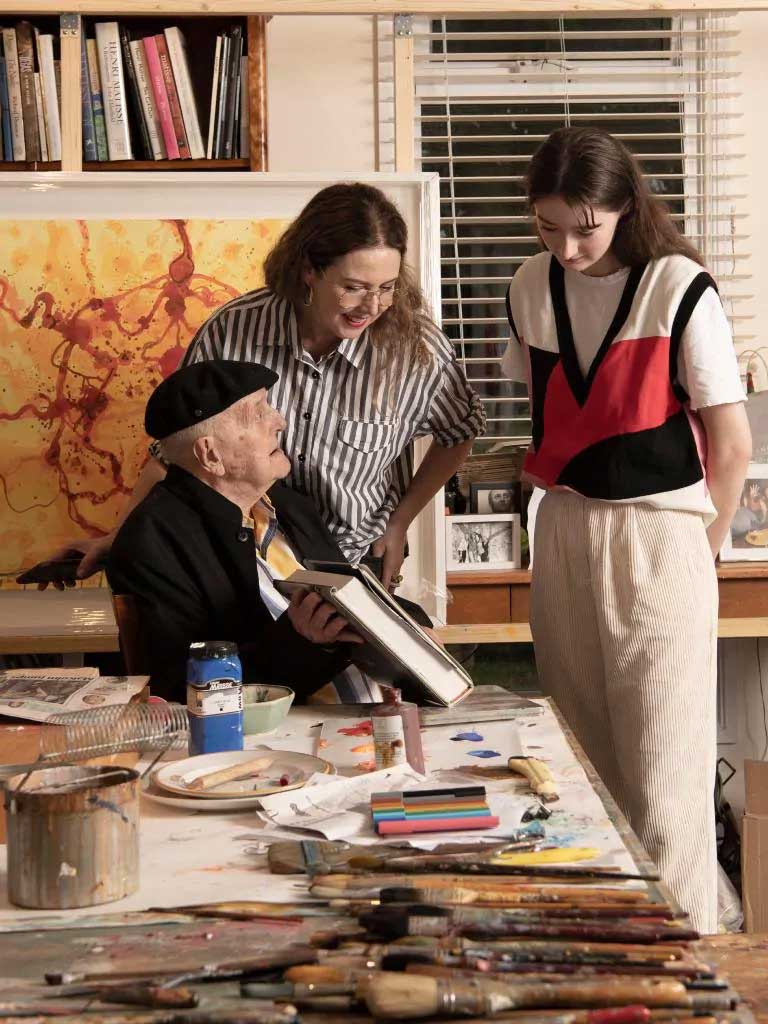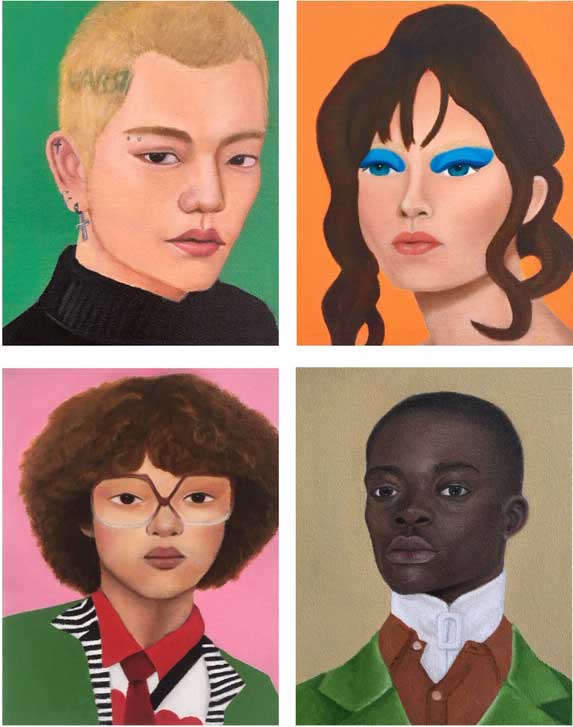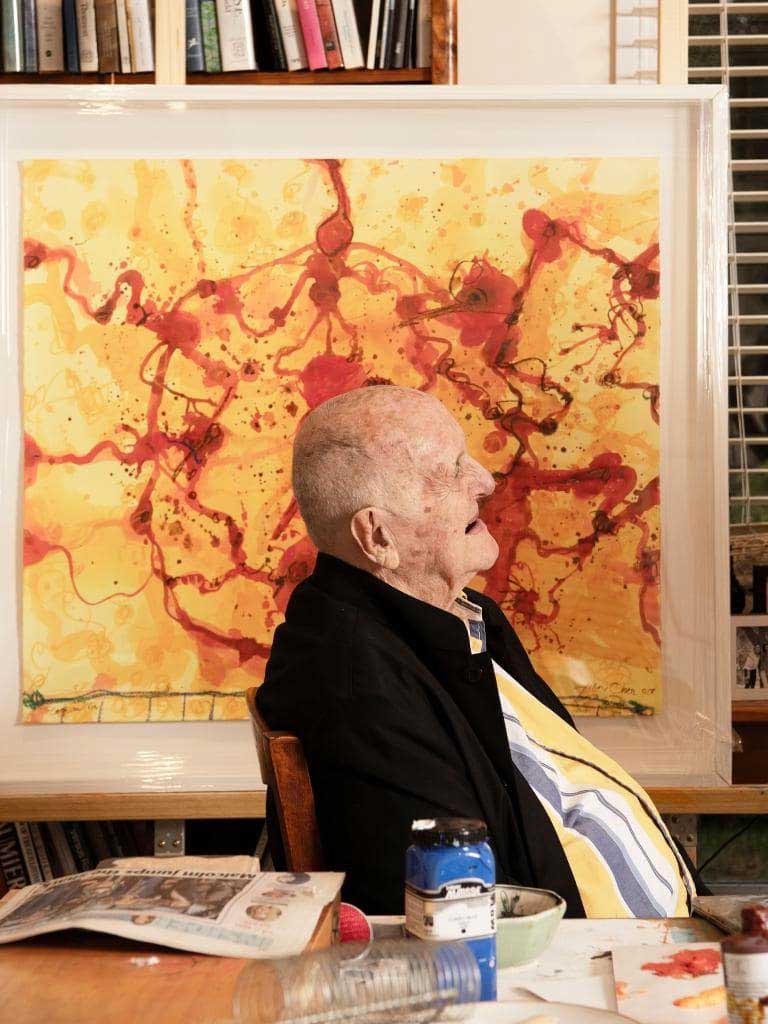News, Press & Videos

Olsen's creative legacy crosses generations
WISH Magazine, The Australian 3 May 2019
Milanda Rout
_view related exhibition
Two more generations of artists are following in the footsteps of patriarch John Olsen - and they're not shy when it comes to giving each other feedback.
Picture: Nic Walker
"Your grand-père is going to be watching!�?� booms John Olsen to his 20-year-old granddaughter Camille Olsen-Ormandy as the pair pore over an art book and discuss the importance of learning to draw. Laughter erupts from one of Australia�??s greatest living artists, as it does from his daughter Louise Olsen and her husband, Stephen Ormandy, the co-founders of Dinosaur Designs and artists in their own right. �??No pressure, no pressure,�?� quips Louise. �??He is watching, he is watching us all!�?�
This extraordinary scene �?? three generations of one famous art family �?? unfolds in John�??s studio at his home near Bowral, in the NSW Southern Highlands. It is an unusually cool and foggy summer morning as the youngest artist in the family receives advice from the oldest. The book they are looking at is on the early drawings of abstract artist Willem de Kooning. �??See, that is what drawing looks like,�?� John says, pointing to one example of the Dutch-American�??s painter�??s work. �??Unless you have a foundation in drawing, you are limited. And the drawing thing is endless. And it�??s wonderful!�?�
The book is sitting on one of many tables �?? covered in paints, bottles of turpentine, paintbrushes, texta pens and paper �?? and surrounded by art from John�??s career on all available wall space. The 91-year-old, sporting his trademark black beret, is holding court as the family discussion turns from art to philosophy and Plato and the concept of pure forms. This writer cannot help thinking that art scholars and students from around the country �?? and the world �?? would be green with envy at the prospect of witnessing such a discussion.
�??For us, it doesn�??t feel like work; it is a passion and we all share this passion,�?� explains Louise of when I ask whether art is a subject that is ever off limits. �??There are always books open and discussions about art or what someone is working on. We are all charged up about it.�?�

John Olsen with daughter Louise and granddaugther Camille. Picture: Nic Walker
WISH is here on this particular February day because Camille has ventured out as an artist, into portraiture, while studying fine arts at the University of Sydney. Late last year Louise opened her first exhibition of her paintings, along with Stephen�??s, at a gallery in Newcastle �?? 34 years after they made their mark in the world of jewellery and homewares with Dinosaur Designs. It seems painting is in the Olsen DNA.�??It was almost like, thank God; what a relief, as you are genetically predisposed to it,�?� Stephen says when Camille decided she wanted to join the family business. He remembers the moment he realised this �?? it was outside a gallery in New York. Camille spent her childhood �??being dragged�?� around galleries in cities where her parents set up stores for the ever-expanding Dinosaur Designs. She would shriek �??nooooo more art galleries�?� on a regular basis, until this particular day. �??We went through a number of galleries in New York and got to the end of the street and Camille looked at me and said, �??did we miss anything?�??�?� Ormandy recalls. �??I remember thinking �??yes!�??�?�
Camille also remembers the moment; when she finally wanted to see more art, she wanted to see everything. But it was not until her final year of high school that art went from something she loved �?? and was surrounded by �?? to a possible profession.
�??Ever since I was little I would do arts and crafts and painting,�?� she says. �??Dad�??s studio was a second home as well. I would sit down with textas and paints and go crazy. It was something really fun to do but I never thought �??this is my career�??. It finally hit me that it was something I would like to take seriously when I had to submit my final piece of work in high school. There wasn�??t anything else I wanted to do.�?�
The big game changer for this third-generation Olsen when it comes to establishing a career as an artist is the digital world. Camille not only uses social media to put her entire portfolio up publicly, but also to get commissions for portraits and to sell pieces. �??I find it�??s easier for young artists to get their name out now,�?� she says. �??All my work has come through Instagram.�?� She is also experimenting with digital technology. �??I paint a portrait and put it on my computer and make the face move. I have done it a couple of times with an app on my phone and I have put it on Instagram and everyone freaks out: �??Oh my God it�??s moving, it�??s moving!�??�?�

Clockwise from top: Zing; Blue Shadow; Velvet Green and Yama. Camille Olsen-Ormandy, all oil on canvas, 17cm x 23cm
It could not be more different from what John had to do to establish his career �?? and make ends meet. �??When I was a student at university, it was a hopeless situation,�?� the Newcastle-born artist tells WISH over tea and toast at the family�??s kitchen table. �??You were never going to make a living and you were going to have a life of penury. But we were born to be artists so I was prepared for that.�?�He says that when he started in the 1950s, Australian art was not valued. There were no auction houses and only two galleries in Sydney (one of those in David Jones). The top price for a Russell Drysdale painting was a mere 110 guineas (about £115).
�??Second to that was [William] Dobell, which was 100 guineas, and then it cascaded down to us, in which case it was five guineas,�?� recalls John. �??So what has subsequently happened has been remarkable. The interest in Australian art has catapulted from the 1960s after the success of the Australian exhibition that went to London in 1963, and also the advent of auction houses. There were none before because there was no bloody money.�?�

Artist John Olsen. Picture: Nic Walker
After travelling to Europe for a few years, John spent his early career painting in the living room of his weatherboard home in Watsons Bay, which he shared with his second wife Valerie, also an artist, and his three children. Louise and her siblings would often go into Olsen�??s studio/living room and have a go themselves. �??We used to get up at 5am and Dad was right across the hall asleep, and we would venture into his studio, get the brushes out and do a little number at the bottom,�?� Louise recalls, laughing. �??It was a shock,�?� John says of walking in and finding his work finished by his children. Sometimes he kept the additions, sometimes he would wipe them out. �??There is a big ceiling of mine at the Newcastle Art Gallery and it has my son�??s tiny handprint on it,�?� John says. �??That was very charming as he was only two years old.�?�Not only did this upbringing immerse Louise in the world of art (�??For me it was never a choice; it totally seeped into me since the day I was born�?�), it also introduced her to the realities of life as an artist. So when she went to art school and met Stephen, they decided to set up Dinosaur Designs and make fimo (polymer clay) jewellery simply to make money and survive. The pair, along with fellow art student Liane Rossler, would sell their wares at Paddington Markets.
�??Everyone has their own creative endeavours and you are along for this beautiful journey as well. You have all these people behind you.�??
�??It was Louise who had the vision,�?� says Stephen. �??I was at art school and I believed I was just about to become a very successful artist and I am going to live off my work. I remember Louise saying, okay, let me explain �?? I have lived this process and I know it.�?� Dinosaur Designs took off and within a few years the trio began experimenting with other materials (painted resin) and exporting to the US. They opened their first retail store in Sydney and were invited to be part of an exhibition at London�??s Victoria & Albert Museum.
The other aspect of Dinosaur Designs that was attractive to Louise was that it was a space her father did not inhibit �?? the downside of being the daughter of famous painter. �??I was always an artist, but I went into the design world because I felt more liberated as people wouldn�??t compare my work and say �??Is it like her father�??s?�??�?� she says. �??I didn�??t get those comparisons in the design world, but the core of me, the truth of me, was an artist and a painter.�?�
It has taken decades for Louise to step out of her father�??s shadow. Exhibiting her own artworks with Stephen at Newcastle Art Gallery late last year �??was the first time I had shown my paintings�?�, she says. �??I had been shy about my paintings; I felt very revealed. Because of the family I come from, sometimes I found the scrutiny intense, so I always was a bit fearful. But I am in the mindset that I don�??t care because I am doing what I love.�?�
Despite having a famous father, Louise says she wouldn�??t have it any other way. �??I am so proud of him and my mother,�?� she says. �??It has been such an enriching experience and life. I have grown and learnt so much.�?� Camille agrees, saying she has had the good fortune to have great artists as parents and also as grandparents. �??Within our family, everyone has their own creative endeavours and you are along for this beautiful journey as well,�?� she says. �??You have all these people behind you who give you context and tell you to look at this in a certain way, to help you and to guide you.�?�
And what about critiquing each other�??s work? Is everyone nice to each other? Is it more about encouragement than criticism? All three generations burst into laughter. �??Dad has a studio down there,�?� Louise says, pointing to one end of the house, �??and I have a studio on the other side. I painted my last exhibition here and Dad comes in at the end of the day and he is like, �??Well �?� �??. Thanks Dad.�?�
�??You are so vulnerable when you are in the middle of painting,�?� adds Camille. �??And you come to your parents for some kind of support and you say �??Is this good?�?? and they say �??Oh, it�??s not your best.�?�
It is all about being honest, says Stephen, otherwise feedback loses its value. �??When Louise walks back into the studio and says �??Wow�??, it really means something because she is actually loving what I am doing,�?� he says.
�??You have to have that rigour and have that critical eye,�?� Louise confirms.
Back in the studio, at the end of the discussion on the works of de Kooning and Jackson Pollock, John is quizzing Camille about her art education and the value of having such an extraordinary grandfather becomes apparent. �??I want to know what that school is up to,�?� he says. �??Anything that doesn�??t introduce you to understanding the world graphically is letting you down. Any help you need, you come to me.�?�